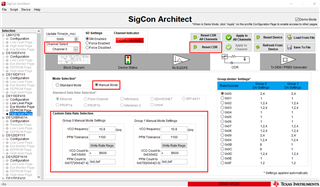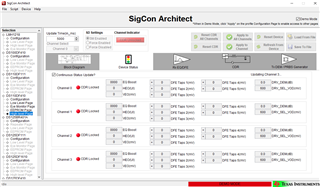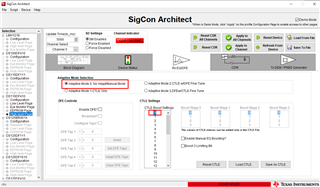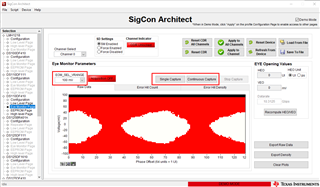Other Parts Discussed in Thread: DS110DF410, DS125DF410, USB2ANY
Hi,
Is it possible to create a 4K HDMI- Signal Eye Monitor with DS100DF410 connected via USBANY to SigCon software ?
Best Regards
Martin
This thread has been locked.
If you have a related question, please click the "Ask a related question" button in the top right corner. The newly created question will be automatically linked to this question.
Hi,
Is it possible to create a 4K HDMI- Signal Eye Monitor with DS100DF410 connected via USBANY to SigCon software ?
Best Regards
Martin
Hi Martin,
DS100DF410 is a retimer designed for 10G ethernet and only supports data rates of 10.3125 Gbps and 1.25 Gbps with NRZ signaling. I'm not too familiar with HDMI, what data rate and signaling are being used here?
Best,
Lucas
Hi Martin,
DS100DF410 locks to 10.3125 Gbps and 1.25 Gbps only. We do have DS110DF410 which supports 8.5-11.3 Gbps + subrates of divide by 2/4/8, and DS125DF410 which supports 9.8-12.5 Gbps + subrates of divide by 2/4/8. Both of these devices will support 5.4 Gbps. Allow me to check with my colleague who is an expert on HDMI and get back to you on our ethernet retimers' support of HDMI signals.
Best,
Lucas
Hallo Lucas,
Die Auflösung der Augenüberwachung ist bei TMDS1881 nicht so gut. Deshalb die Anfrage mit DS1XXDF410 Eye Monitoring, ob es mit HDMI-Signal funktionieren würde?
Regars
Martin
Hi Martin,
I see, DS110DF410 or DS125DF410 can be used to monitor the eye opening of HDMI signals with the following caveats.

Given these caveats, are you still interested in using DS110DF410 or DS125DF410 to monitor eye opening? If you are, then I can share additional instructions on how to configure the retimer. Are you planning to use SigCon Architect GUI, or directly read/write SMBus registers?
Just to confirm, you only want to use DS1xxDF410 to monitor the eye opening, correct? I don't think DS1xxDF410 would be a good fit to implement in an HDMI application.
Best,
Lucas
Hi Lucas,
That sounds good with the eye opening monitor for HDMI signals with DS110 or DS125 IC, using the SigCon Architect GUI. I would be grateful for configuration instructions.
Regards,
Martin
Hi Martin,
Note that a USB2ANY device is required to interface between the retimer SMBus and an external PC in order to use SigCon Architect GUI. I suggest reviewing the DS1xxDF410EVM User's Guide for general instructions on SigCon Architect Installation and Configuration.
snlu126c_ds1xxdf410evm_users_guide.pdf
After powering on the retimer, transmitting the signal to RX pins, and connecting to the device through SigCon Architect, navigate to the CDR tab on the High level Page. Make sure the correct channel is selected. Choose Manual Mode and configure the Custom Data Rate Selection as shown for 5.4 Gbps (10.8 divide by 2). Click Reset CDR.

Check on the Device Status tab that the corresponding channel has obtained CDR lock (shown with a green indicator).

On the Rx EQ/DFE tab, select Adapt Mode 0 and CTLE Boost 0. This will set the CTLE to the minimum boost setting. Click Reset CDR again and confirm the channel obtains CDR lock again.

On the Eye Monitor Page, select the correct EOM voltage range, then click Single Capture or Continuous Capture to see the eye diagram. Note that the EOM is not expected to show meaningful results if CDR is not locked.

Let me know if you have any issues or questions and I can help support.
Best,
Lucas